Puffadder Shyshark
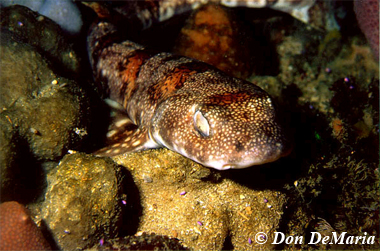
Haploblepharus edwardsii
This long, slender catshark prefers deeper cold waters off of coastal South Africa where it lies sedentary on the seafloor and scavenges crustaceans, polychaetes and small fishes. It is a sandy brown, with dark-outlined reddish saddles and dark and white spots, providing great camouflage. From rounded snout and oval cat-eyes to stout caudal (tail) fin, it rarely grows more than 24 inches long. It is considered harmless to humans, and is not a sought-after food fish.
Order – Carcharhiniformes
Family – Scyliorhinidae
Genus – Haploblepharus
Species – edwardsii
Common Names
English language common names include puffadder shyshark and puff-adder shy shark. Other common names are alitán viperino (Spanish), pofadder-skaamoog (Afrikaans), pofadderschaamhaai (Dutch), roussette vipérine (French), skaamoog (German), slangerødhaj (Danish), and zralok stydlivý (Czech).
Importance to Humans
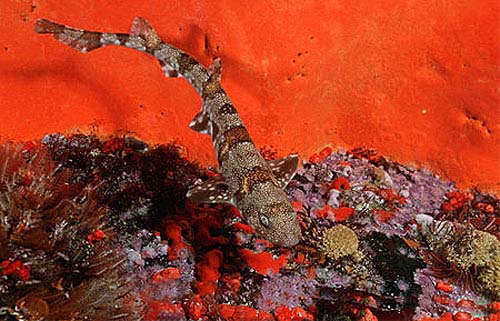
Although not important commercially, this shark is captured in local subsistence fisheries. This species is often caught with rod and reel by recreational surf anglers. However, it is considered a little-utilized species due to its small size. It is probably discarded from bottom trawlers in the region as bycatch while recreational fishers often discard the puffadder shyshark (among other catsharks) as bycatch due to its reputation as a minor pest species.
Danger to Humans
The puffadder shyshark poses little threat to humans due to its small size and feeding habits.
Conservation
The puffadder shyshark is listed as “Lower Risk/Near Threatened” with the World Conservation Union (IUCN). The IUCN is a global union of states, governmental agencies, and non-governmental organizations in a partnership that assesses the conservation status of species. This small catshark resides in a very limited range off the coast of southern Africa. This region is heavily fished and has potentially degraded inshore water quality. If fishing increases in inshore waters or habitat is further degraded, the population of this endemic species could be greatly impacted.
> Check the status of the puffadder shyshark at the IUCN website.
Geographical Distribution
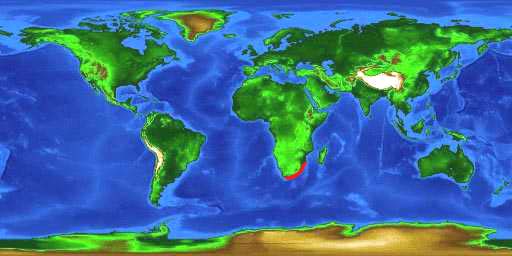
The range of the puffadder shyshark is limited (endemic) to the southeast Atlantic from Cape Agulhas to Natal in South Africa. Two different forms of this species exist and are referred to as the “Cape” and “Natal” types. These types differ in coloration as well as habitat and are thought to be variants based on geography or they may be two distinct species.
Habitat
Puffadder shysharks are found over sandy and rocky bottom habitats in waters both inshore and offshore of the continental shelf. This shark ranges at depths from the surfline to 427 feet (130m), however it is most common offshore from 98-295 feet (30-90m). The “Cape” form of this species resides in deeper cold water while the “Natal” form is found closer inshore in waters ranging from the surf line down to 98 feet (30m) depth.
Biology
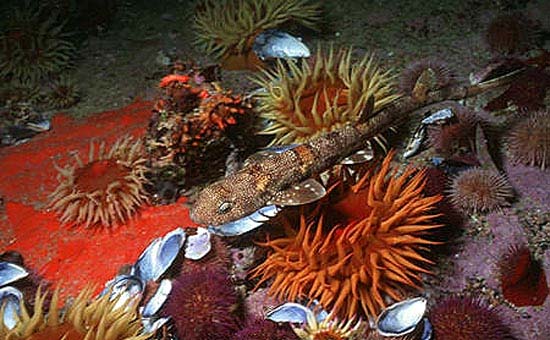
Distinctive Features
This catshark has a broad head with slit-like eyes and stout fusiform body. It has a nictitating eye lid that can cover the exposed portion of the eye. The greatly expanded nasal flaps lack barbels, extending to and overlapping the mouth. Labial furrows are present along both the upper and lower jaws. The gills of the puffadder shyshark are located dorsolaterally. This shark posseseses two spineless dorsal fins. The origin of the first dorsal fin is located over or just behind the insertions of the pelvic fins. The origin of the second dorsal fin is over or slightly behind the anal midbase. The pectoral fins are moderately large. The pelvic and anal fins are similar in size to the two equal-sized dorsal fins. The claspers of male specimens are moderately long extending approximately half their length past the pelvic fin tips. The origin of the anal fin is located behind the pelvic bases while the caudal fin is relatively short and broad.
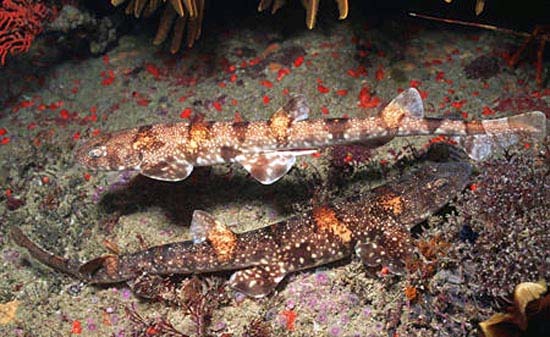
Coloration
The puffadder shyshark has a variegated coloration pattern consisting of dark edged dorsal saddles bordered by darker margins. The saddles are dotted with small white dots equal to or smaller than the spiracles. The “Cape” form is sandy brown with seven dark reddish-brown saddles edged in black along with small dark brown and white spots located between the saddles, while the ventral surface is white in color. In contrast, the rarer “Natal” form has much darker saddles with irregular white spots on a creamy colored background while the ventral surface is white.
Dentition
The small mouth contains compressed teeth with distal cusplets and broad bases in the upper jaw and moderately long teeth with nearly straight smooth-edged cusps in the lower jaw. There are 26-30 rows of teeth in the upper jaw and 27-33 rows in the lower jaw with three of these rows located at the symphysis of the jaw. Males have longer, three-pronged teeth while females have shorter five-pronged teeth.
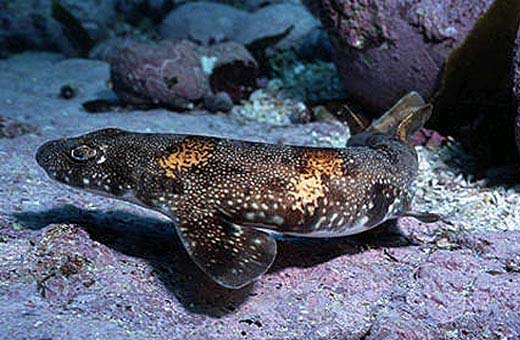
Denticles
The body of the puffadder shyshark has thick skin and is covered in well-calcified dermal denticles.
Size, Age, and Growth
The maximum reported length of the puffadder shyshark is 23.6 inches (60cm) total length. Males reach maturity at 16.5-20.1 inches (42-51cm) total length while females mature at 16.1 inches (41cm) or larger. Specimens from the southwestern Cape Province may mature at a slightly smaller size than those individuals from the northern Natal region.
Food Habits
Puffadder shysharks feed on small bony fishes including anchovy, maasbanker, gobies, and gapers. Other prey items include crabs, shrimp, mysids, hermit crabs, mantis shrimp, squid and polychaetes. They are also known to feed on fish offal.
Reproduction
The puffadder shyshark is oviparous with a single egg case laid per oviduct. Egg cases measure 1.4-2.0 inches (3.5-5.0 cm) in length and 0.6-1.2 inches (1.5-3.0 cm) in width and possess tendrils at each lateral end. The period of embryonic development within the egg case after being released from the female is approximately 104 days. Upon hatching, the young measure 10cm in length.
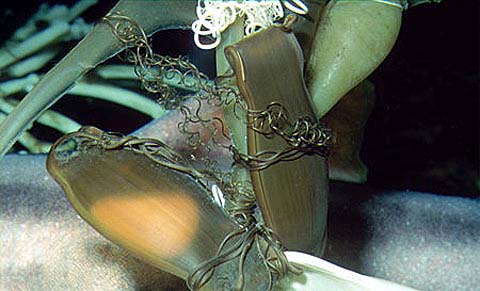
Predators
Predators of the puffadder shyshark include the Cape fur seal Arctocephalus pusillus pusillus and the black-backed kelp gull Larus dominicanis vetula. Other potential predators include larger fishes such as sharks.
Parasites
Larvae of the isopod, Gnatha pantherina n. sp., have been documented from the gills, nares, and bucchal cavity of five puffadder shysharks. Trypanosoma haploblephari n. sp. (Kinetoplastida: Trypanosomatidae) has been found in the blood of puffadder shysharks from the south and west coasts of South Africa. Nematodes (including Proleptus obtusus) are also known parasites of this catshark.
Taxonomy
The puffadder shyshark is a catshark in the family Scyliorhinidae. Originally named Scyllium edwardsii by Voigt in 1822, this shark’s scientific name was later changed to the currently valid Haploblepharus edwardsii (Voigt in Cuvier 1832). The genus Haploblepharus is derived from the Greek “haploos” meaning single and “blepharos” meaning eyelash.
Prepared by: Cathleen Bester